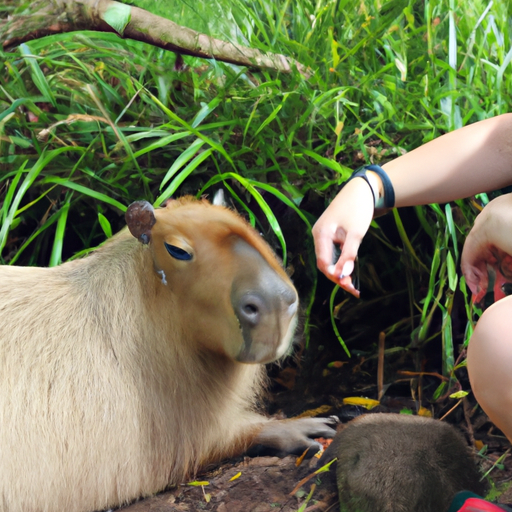Table of Contents
If you've ever wanted to pet a capybara, you're in for a treat! These adorable, giant rodents are known for their friendly nature and love to be petted. But where exactly can you experience the joy of stroking their soft fur? Look no further as this article highlights the best spots to pamper these delightful creatures. Whether it's a petting zoo, a wildlife sanctuary, or even a specialized capybara café, get ready to unleash your inner animal lover and enjoy some quality time with these gentle giants.
Capybaras in the Wild

1.1. Habitat of Capybaras
Capybaras, the largest rodents in the world, are native to South America and can be found in a variety of habitats such as savannas, grasslands, and wetlands. They are highly adaptable creatures and are known to thrive in both freshwater and terrestrial environments. Capybaras are excellent swimmers and take refuge in bodies of water to escape predators or regulate their body temperature. These social animals prefer densely vegetated areas near water sources where they can graze on a variety of plants and easily find shelter.
1.2. Behavior of Capybaras
Capybaras are fascinating creatures known for their sociable and docile nature. They usually live in large groups called herds, which consist of several individuals, including males, females, and their offspring. These herbivores are diurnal, meaning they are most active during the day. They have a peaceful temperament and are often observed resting or leisurely grazing in their natural habitat. Capybaras are excellent communicators and use a wide range of vocalizations, postures, and scent marking to interact with their group members.
1.3. Interaction with Wild Capybaras
Interacting with wild capybaras can be a thrilling experience for nature enthusiasts. However, it is important to respect their natural behaviors and maintain a safe distance to avoid causing any harm or distress. Observing these social creatures from afar and appreciating their beauty in their natural environment ensures the preservation of their wild populations and the protection of their habitat.
Capybaras in Captivity
2.1. Capybara Sanctuaries
Capybara sanctuaries provide a safe haven for these gentle giants, offering them a protected environment in which they can live comfortably. These sanctuaries often focus on the rescue, rehabilitation, and release of capybaras that have been in distress or were once captive pets. In these facilities, visitors can learn about the natural behaviors and conservation efforts of capybaras while enjoying the opportunity to observe and occasionally interact with them under the guidance of knowledgeable staff.
2.2. Petting Zoos and Exotic Animal Parks
Petting zoos and exotic animal parks sometimes include capybaras among their diverse range of animal attractions. These environments aim to provide educational experiences for visitors, particularly younger audiences, by allowing them to come into close contact with various animals. In the case of capybaras, supervised interactions can help foster appreciation for these unique creatures while promoting empathy and a sense of responsibility towards wildlife.
2.3. Private Reserves and Farms
Some private reserves and farms also offer the opportunity to interact with capybaras. These establishments often breed and care for capybaras in a controlled and regulated environment. Visitors may have the chance to pet or feed the capybaras while learning about their dietary needs, social behaviors, and conservation status. It is crucial to choose reputable and ethical locations that prioritize the well-being of the animals and support conservation efforts.
Popular Capybara Destinations
3.1. South America
South America is the native home and the best place to observe capybaras in their natural habitat. Countries such as Brazil, Argentina, and Venezuela are known for their diverse wildlife, including thriving populations of capybaras. National parks and reserves, such as the Pantanal in Brazil or the Esteros del Iberá in Argentina, offer fantastic opportunities to spot and appreciate these unique creatures. Joining guided wildlife tours or hiring local guides can greatly enhance the chances of encountering capybaras while also supporting sustainable ecotourism initiatives.
3.2. North America
Although capybaras are not native to North America, they can be found in certain regions where they have established feral populations. Some examples include parts of Florida, Texas, and Louisiana. These feral capybaras, descendants of escaped or released pets, can sometimes be observed in the wild, particularly in wetland areas. It is important to remember that these populations are not native and should not be disturbed or interacted with in order to maintain the delicate balance of local ecosystems.

3.3. Europe
In Europe, capybaras are primarily found in captivity rather than in the wild. Zoos and wildlife parks across the continent offer visitors the chance to see capybaras up close and learn about their natural history. Explore reputable and accredited institutions that prioritize animal welfare and conservation education.
3.4. Asia
Similar to Europe, capybaras can also be found in selected zoos and wildlife parks in Asia. These facilities provide opportunities for visitors to discover and engage with capybaras, offering insights into their behaviors, habitat, and the importance of their conservation. Support establishments that meet high standards of animal care and contribute to conservation efforts.
Interacting with Capybaras
4.1. Capybara Body Language
When approaching or observing capybaras, it is essential to understand their body language to ensure a positive interaction. Capybaras use a combination of vocalizations, postures, and movements to communicate their intentions and emotions. They may express contentment through relaxed movements, gentle vocalizations, and visible grooming behaviors. On the other hand, signs of aggression or discomfort often include raised fur, bared teeth, and hissing or growling sounds. Observing these cues can guide you in adjusting your behavior to ensure a respectful and safe encounter.
4.2. Recommended Approaches
To interact with capybaras, it is important to approach slowly and calmly, allowing them to become familiar with your presence. Giving them ample space and avoiding sudden movements or loud noises helps create a calm and relaxed atmosphere. Additionally, offering treats or food approved by the staff can help establish trust with capybaras. Remember to follow any rules or guidelines provided by the facility or expert handlers to ensure the well-being of both you and the capybaras.
4.3. Avoiding Distress or Harm
While interacting with capybaras, it is crucial to prioritize their well-being and minimize any potential distress or harm. Do not attempt to chase, startle, or corner capybaras, as this can cause anxiety or even aggressive reactions. Respect their personal space and avoid prolonged physical contact, as capybaras still retain their wild instincts and may feel threatened in certain situations. Always prioritize the welfare and safety of the capybaras by adhering to the instructions provided by trained professionals.
Considerations for Petting
5.1. Legal Restrictions
Before considering petting a capybara, it is important to research and understand the legal restrictions in your area. Different regions and countries have varying regulations regarding the ownership and handling of capybaras. Some jurisdictions may consider them exotic pets and require specific permits or licenses. Always ensure that you are in compliance with the law to avoid legal consequences and to contribute to responsible pet ownership.
5.2. Health and Safety Measures
Petting capybaras requires a responsible approach to ensure the health and safety of both humans and animals. It is recommended to visit veterinary professionals experienced in capybara care to receive proper guidance on health checks, vaccinations, and necessary hygiene practices. This ensures that potential zoonotic diseases are minimized, protecting both you and the capybaras from potential health risks.
5.3. Ethical Concerns
The decision to pet a capybara should involve careful consideration of ethical concerns. Capybaras have specific social and environmental needs that may be challenging to meet in a domestic setting. Ensure that you have the necessary resources, knowledge, and commitment to provide adequate care for the capybara throughout its life span. Additionally, always prioritize adopting or rescuing capybaras rather than supporting the illegal wildlife trade.
Approved Petting Areas

6.1. Areas to Avoid Touching
While petting capybaras, it is important to be aware of areas to avoid touching to prevent any discomfort or harm. Capybaras have sensitive regions, including their faces, ears, and tails, that may be sensitive to touch. Unless you have received specific guidance from a qualified professional, it is recommended to refrain from touching these areas to ensure the capybara's well-being.
6.2. Safe Spots for Petting
When petting capybaras, concentrate on areas that they find enjoyable and where it is safe for you to touch. Generally, capybaras appreciate gentle strokes along their backs, sides, and hindquarters. Proceed with caution and attentively observe the capybara's reactions to ensure it is comfortable and not exhibiting signs of distress. Recognize that individual capybaras may have unique preferences, and it is crucial to accommodate their personal boundaries.
6.3. Gentle Techniques and Best Practices
To create a pleasant experience for both you and the capybara, utilize gentle techniques when petting. Approach the capybara slowly and offer your hand for it to sniff and get accustomed to your scent. Once the capybara is at ease, use slow and gentle strokes, avoiding any rough or forceful actions. Be considerate of the capybara's reactions and respect its boundaries. Remember, building a bond and trust with the capybara takes time and patience.
Capybara Behavior with Strangers
7.1. Socialization and Taming
Capybaras are highly social animals, often forming strong bonds with their human caretakers when properly socialized from an early age. Socializing and taming capybaras involves consistent positive reinforcement, trust-building exercises, and early exposure to human touch. This process requires patience, dedication, and a deep understanding of capybara behavior to ensure a successful and respectful relationship between humans and capybaras.
7.2. Recommendations for First-Time Handlers
For individuals who are new to handling capybaras, it is advisable to seek guidance from experienced capybara owners or professional trainers. They can provide valuable insights and practical advice on how to initiate interactions, read capybara body language, and establish a positive rapport. Learning from those with hands-on experience can help prevent common mistakes and foster a harmonious connection between you and the capybara.
7.3. Building Trust and Avoiding Aggression
Building trust with capybaras is a gradual process that requires sensitivity and respect for their boundaries. Allow capybaras to approach you willingly, rather than imposing physical contact upon them. Respect their need for personal space and provide positive reinforcement through treats, verbal affirmations, and gentle interactions. Avoid any actions that may evoke aggression, such as sudden movements or unwelcome touching. By prioritizing their comfort and well-being, you can establish a foundation of trust and nurture a mutually respectful relationship.
Benefits of Petting Capybaras
8.1. Therapeutic Effects
Petting capybaras can have numerous therapeutic effects on individuals. The gentle touch and calming presence of capybaras are known to reduce stress, anxiety, and blood pressure. Interacting with these charming animals provides a soothing and comforting experience, creating a positive impact on mental and emotional well-being. Many therapeutic facilities, such as hospitals or rehabilitation centers, include capybara interactions as part of their therapy programs due to these benefits.
8.2. Educational Opportunities
Petting capybaras presents an invaluable opportunity for education and learning. By interacting with these creatures, individuals can gain knowledge about their behavior, natural history, and the importance of conserving their habitats. Hands-on experiences with capybaras offer a unique chance to foster empathy, environmental awareness, and a deeper appreciation for the diverse wildlife our planet holds.
8.3. Promoting Conservation and Appreciation
Petting capybaras can contribute to conservation efforts by supporting organizations dedicated to preserving their natural habitats and protecting their populations. Facilities that promote responsible petting experiences often allocate a portion of their revenue to conservation initiatives, aiding in the conservation of capybaras and their ecosystems. By participating in these experiences, you are actively engaging in the appreciation and conservation of capybaras as a vital part of our natural world.
Additional Capybara Experiences
9.1. Capybara Cafes and Restaurants
Some establishments have introduced capybara-themed cafes and restaurants, providing a unique dining experience combined with the opportunity to observe these fascinating creatures. While enjoying a cup of coffee or a meal, visitors can admire capybaras in specially designed habitats within the facility. However, it is important to ensure these establishments prioritize the welfare of the capybaras and adhere to ethical practices.
9.2. Volunteering at Capybara Habitats
For those passionate about capybara conservation, volunteering at capybara habitats or sanctuaries can be a fulfilling experience. This offers the chance to actively participate in the care and rehabilitation of these animals, while also learning about their behaviors and contributing to their well-being. Volunteering opportunities may include assisting with feeding, habitat maintenance, and educational programs aimed at raising awareness about capybara conservation.
9.3. Capybara Encounters in Nature Reserves
Exploring nature reserves and national parks that house capybaras can provide unforgettable encounters with these captivating animals in their natural habitat. Joining guided tours or embarking on wildlife viewing adventures can offer the opportunity to observe capybaras engaging in their wild behaviors. Remember to always observe and appreciate from a respectful distance, allowing capybaras to live undisturbed in their natural environment.
Conclusion
Capybaras, with their endearing nature and unique characteristics, have fascinated humans for centuries. Whether observing them in the wild or interacting with them in captivity, it is essential to approach these gentle giants respectfully and responsibly. Through proper education, guided interactions, and supporting ethical establishments, we can appreciate the beauty of capybaras while protecting their well-being and contributing to their conservation. Remember, the joy of petting a capybara comes with the responsibility to ensure their welfare and the preservation of their natural habitats.

